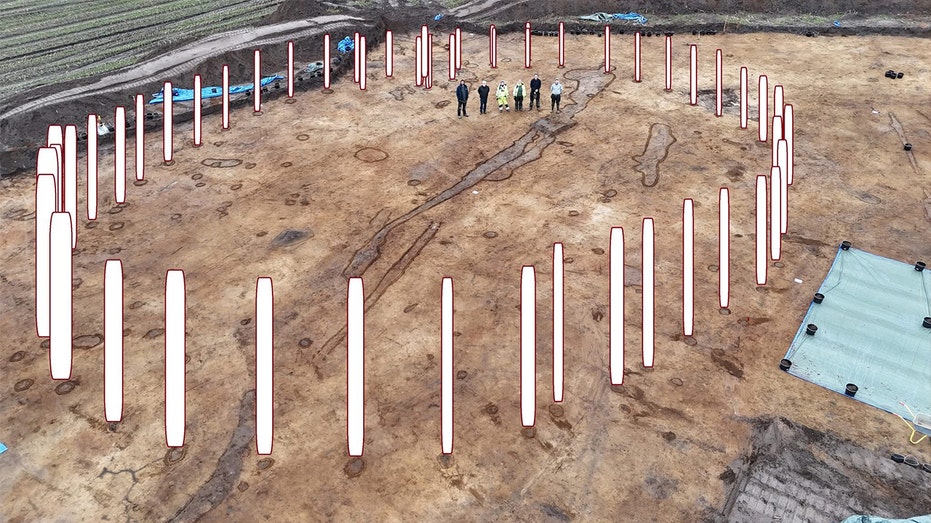- by foxnews
- 10 Mar 2025
Cancer fears plague residents of US region polluted by ‘forever chemicals’
Cancer fears plague residents of US region polluted by ‘forever chemicals’
- by theguardian
- 13 Jul 2022
- in news

In Wilmington, 50-year-old Tom Kennedy thinks it might be time to stop fighting the cancer that started in his breast and now grips his spine. He's endured 85 chemotherapy treatments since an inverted nipple sent him to the doctor five years ago, and he fears the endless struggle to keep him alive is more than his daughters can bear. He wonders if it's time to let death take him so his family can move on.
A deadly cancer has already taken 43-year-old Amy Nordberg away from her family, also of Wilmington. Nordberg died in January after a three-year battle with a vicious cancer that followed the development of multiple sclerosis. The cancer moved through her body faster than doctors expected, enveloping her colon and invading her bone marrow.
Kennedy and Nordberg are only two among many sick and dying people who live in the Cape Fear River basin of North Carolina, where environmental testing has found persistently high levels of different types of toxic compounds known collectively as per- and polyfluoroalkyl substances, or PFAS.
Several industries operating in the area have been using PFAS for years, while DuPont and successor Chemours have been producing the chemicals at a plant in Fayetteville situated along the river. PFAS are typically part of the manufacturing of thousands of products resistant to water, heat and stains.
Some of the most widely studied types of PFAS have been linked to a range of human health problems, including cancers. They're called "forever chemicals" because they don't degrade and accumulate in the environment and human bodies.
But despite more than 20 years of warnings from public health advocates, exposure to the chemicals remains almost impossible to escape - particularly for the people of the Cape Fear River basin.
The physical and emotional suffering that comes with living in an area polluted by toxins is ripping through families, scarring lives and short-circuiting dreams for the future.
Making it all worse is the fact that while many people feel certain the health problems they or their friends and loved ones are experiencing are connected to the PFAS pollution, confirming those suspicions has been almost impossible. State and federal regulators have resisted requests for in-depth studies.
"The response is not proportional to the harm that's been committed here," said Emily Donovan, co-founder of the Clean Cape Fear advocacy group, created in 2017 in response to the crisis.
Chemours has acknowledged the concerns about PFAS contamination and says it has been working for several years to address them with residents and regulators.
Still, the signs of contamination are all around. On beaches in Oak Island, near where the Cape Fear spills into the Atlantic Ocean, children build sandcastles and splash in PFAS foam, a form of toxic waste. When it rains, PFAS-laced foamy water bubbles in gutters in the town of Leland.
PFAS contamination has been documented throughout the region - in drinking water; in air and soil samples, in crops, in livestock and fish; and, notably, in blood samples taken from people who live and work in the area.
The basin is considered an important natural resource for drinking water, agriculture, and recreation. But the 450,000 residents and another 200,000 tourists who visit the area annually risk exposure to PFAS contaminants, experts say.
It all makes the region a perfect "petri dish" for PFAS research - a chance to study how 40 years of exposure to a broad cross-section of PFAS affects a large population's health, according to a coalition of community and environmental justice groups that have demanded a comprehensive research program on 54 PFAS emitted by the Chemours plant.
The EPA has rejected the requests and has said it will analyze only seven PFAS and attempt to extrapolate their health impacts and toxicity data across the entire class of more than 9,000 PFAS compounds.
Last month, the coalition sued the EPA over the issue.
"We're outraged - they basically gave us nothing," said coalition attorney Bob Sussman.
The problems in Cape Fear persist even after the Biden administration last year launched a sweeping multibillion-dollar project aimed at reducing PFAS use and public exposure to the chemicals.
Because the chemicals don't naturally break down, meaningfully reducing levels in drinking water near the plant and remediating the land will probably take decades, said Detlef Knappe, a PFAS researcher with North Carolina State University.
"Peoples' lives really got turned upside down because it's not just drinking water, it's likely food, fishing, swimming in the lakes, property values: all of these things won't change for the foreseeable future," Knappe said. "It's a tragedy, a travesty, and, yes, it's a result of four decades of Chemours basically operating without oversight in terms of those compounds."
DuPont owned Fayetteville Works until it spun off Chemours in 2015 to protect itself from PFAS-related legal liabilities.
Researchers estimate Cape Fear residents spent decades drinking water with staggering PFAS levels, exceeding 100,000 parts per trillion (ppt) - far above the federal advisory level in effect since 2016 of 70 ppt for two kinds of PFAS. Some public health groups say no amount above 1 ppt is safe. The EPA recently updated its advisory levels, dramatically reducing the levels considered safe to below 1 ppt.
Low-income residents who can't afford costly filtration systems, who subsist on fish in the river and who have less access to information are more vulnerable.
Though Chemours is not the only PFAS source in the watershed, a study Knappe co-authored linked a significant portion to Fayetteville Works.
Chemours states on its website that over the last five years it has "taken numerous steps to dramatically reduce water discharges and air emissions" of PFAS and other compounds from the Fayetteville Works plant.
Though Chemours stopped discharging PFAS directly into the Cape Fear River in 2017, the aquifers around Fayetteville still teem with decades worth of contamination.
The chemicals move into the river and that helped push drinking water levels around Wilmington to 380 ppt in January - well above what's considered safe. Almost all of the 10,000 wells tested in the region show some level of PFAS contamination and over two-thirds are above the threshold that requires Chemours to provide filtration.
Fayetteville Works installed air pollution controls in 2020 that partially reduced emissions, but state records show some continues. The chemicals are volatile, also meaning they can move from the ground into the air. Then, as PFAS drop or rain down on the region's sandy, red soil, they can move back into the aquifers and re-contaminate drinking water. The toxins have even been found at high levels in kale, lettuce, tomatoes, blueberries and blackberries. The chemicals are also consumed by wildlife.
Though regulators have refused to conduct blood studies, a North Carolina State analysis of blood samples from more than 500 residents has confirmed the presence of some Chemours-produced PFAS compounds in the blood samples.
About a week after an early May spine surgery, Kennedy lay weakened in a rehabilitation center bed, his contorted, frail body covered in bruises and sores. His wife, Christine, helped him change positions and sip juice from a straw.
Though doctors say he could live several more years if he continues treatments, Kennedy said his constant sickness is ruining the lives of his children, trapping them in a steady state of grief.
"How many times can they see me get put into an ambulance?" he asked from the hospital bed. "Who wants to die? I don't, but I have to do what's right for them.
Beth Markesino, 38, who lives roughly 11 miles away from Kennedy, still mourns the loss of a 2016 pregnancy she believes is connected to the fact that she drank water potentially laced with PFAS. About 23 weeks into her pregnancy, sharp stomach pain sent Markesino to doctors who found her unborn child had not developed kidneys, a bladder or bowels, and wasn't producing amniotic fluid.
Six months after burying the boy she named Samuel at a family plot in Detroit, Markesino saw a local news story reporting that PFAS linked to pregnancy complications had contaminated her drinking water.
"I'll never know 100% if that's what happened with my son, but I drank the water, and I drank tons of it," Markesino said. She has since suffered from PFAS-linked health problems that include ovarian cysts, thyroid cysts and tumors.
Over 70 miles west, near Fayetteville, 38-year-old Adrian Stokes suffers from health problems that include thyroid disease, kidney cysts, pulmonary embolisms, an autoimmune disorder, an enlarged liver and debilitating exhaustion.
"I feel like I could probably kill myself because of how bad I hurt," he said. Pets he once had also suffered a range of health problems.
A few miles away, US army veteran Mike Watters founded a citizens' group to seek answers on PFAS contamination concerns after his three dogs died of pancreatic cancers. He helped connect 30 local owners of sick dogs and horses with university researchers who drew blood from the animals, tests that confirmed the animals were contaminated with PFAS too.
The blood test results and other data has been shared with state officials, and the legislature did create a PFAS Collaboratory made up of university researchers to study contamination. But the Collaboratory can't enforce laws, fine companies or order cleanups.
And even though Chemours is operating under a 2019 consent order issued by regulators, the company has regularly violated that order.
For Amy Nordberg's husband, Jonathan Shands, the push for research comes too late. He has little doubt about who and what to blame for her January death. Tests showed Chemours' PFAS not only in the family's drinking water, but also in his wife's blood.
Before she developed cancer, Nordberg was diagnosed with multiple sclerosis, which new science links to PFAS exposure. Then, over the course of three agonizing years, a cancer that first attacked her sinuses and face spread rapidly.
Nordberg had been determined to live long enough to see the couple's daughter Izzy, 15, graduate from high school. But the cancer moved too fast, attacking her colon and bone marrow late last year.
"We thought we had time," Shands said. "But none of that happened. Chemours can hide behind lawyers and they can do whatever they want to do. The fact is, she is no longer here. And that's not going to bring her back."
- by foxnews
- descember 09, 2016
Ancient structure used for cult 'rituals' discovered by archaeologists
A Neolithic Timber Circle was discovered by archeologists in Denmark resembling the historical landmark Stonehenge in the U.K. It is open to be viewed by the public.
read more


